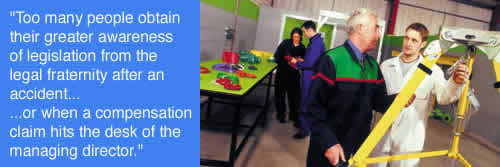

Training in Health and Safety is not a new concept, yet the same problems seem to continually crop up. Week after week the press is filled with stories of accidents, prosecutions and examples of bad practice. Training is more widely available than ever before – so why is the message not getting through?
From my experience of delivering lifting operation training across a number of industries, there seems to be a common thread emerging which goes some way to explaining the above.
Unfortunately, too many people obtain their greater awareness of the Health & Safety legislation from the legal fraternity after an accident, when claims of malpractice are sought, or when a claim for compensation hits the desk of the Managing Director. Even where companies and individuals try to be fully aware of the legislation, it is not always easy to decipher just how it affects them and what, in the way of training, it requires them to do. There is a ‘gap’ that seems to exist between the legislation and a company’s understanding of its requirements, and with the increasing number of new regulations, this gap is becoming more and more difficult to span.
By its very nature the legislation is both broad and general. This makes interpretation difficult especially for non-Health & Safety professionals. This means that they have a wider range of responsibilities coupled with the day to day pressure of reaching targets, managing staff and generally making money for the company. Perhaps understandably, Health and Safety is often seen as a distraction, and as such can slip down the list of priorities of managers. Many managers I speak with feel very uncomfortable with their task of unravelling the requirements of new legislation. They do not feel at ease with understanding what is needed for their particular area of operation. The required time, knowledge and expertise is often not available to a manager, making it difficult for them to become familiar with the legislation, interpret what it requires them to do, and implement the measures with any degree of confidence.
An obvious example of this scenario is the Lifting Operations and Lifting Equipment Regulations (LOLER). Despite being over 2 years old, they are not widely or fully understood by many people and businesses. Even where those responsible are aware of the legislation, the training for lifting operations is done superfluously in the context of wider, generic Health and Safety training, and does not recognise the specialist nature and the depth of its requirements. The LOLER regulations specify quite sophisticated training at a number of levels in an organisation in order to comply; training which generic health and safety overviews cannot cover. It is therefore unfortunate that companies who may have invested substantial sums of money in Health and Safety training for their staff, and who may feel that they have successfully covered all avenues, will have not given the staff sufficient training for many lifting operations. This, worryingly, can leave the organisation liable should an accident occur.
Companies should avoid waiting for lawyers to give them a full and more accurate understanding of the needs of the legislation and turn to other professionals at an earlier stage. It could be argued that we cannot expect line managers to be experts in everything within their area of responsibility, and thus recognise the need to consult relevant bodies or individuals who are able to offer help in understanding and interpreting the relevant legislation.
It is not only lifting regulations that have become increasingly more complex. There are regulations covering all aspects of Health and Safety which a manager must consider – Control of Substances Hazardous to Health (COSHH), the Management of Health and Safety Regulations, Personal Protective Equipment Regulations, the Provision and Use of Work Equipment Regulations... the list goes on and on.
It is therefore vital that when looking at Health and Safety, line managers and other non-Health & Safety professionals recognise the specialist nature of the majority of the legislation. The above example illustrates the need to consult external bodies specialising in specific areas of legislation. This will help managers in fully understanding the implications of the legislation for their specific business.
The ‘gap’ that exists between companies and the legislation is not one that can be easily crossed alone. Assistance from experienced and professional bodies in interpreting the regulations is imperative if managers are to feel confident that they have covered all eventualities.
Wilfred Manjengwa
Head Of initiative
Lifting Equipment Training initiative (LETI)

